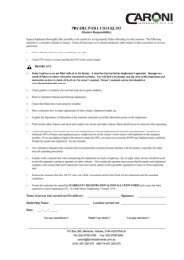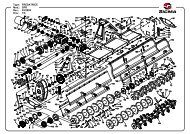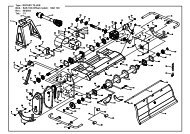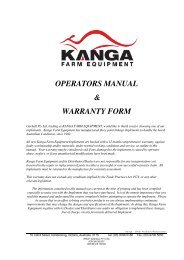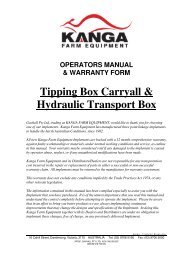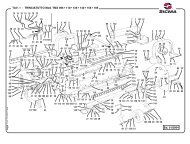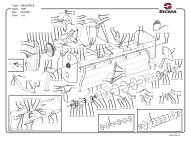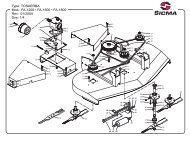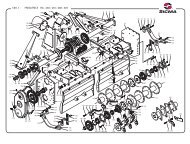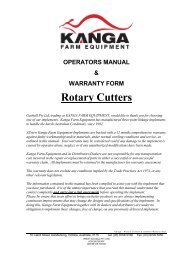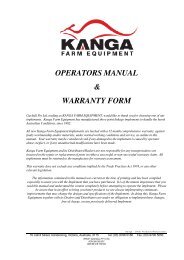Carryall, Jib, Bale Equipment Manual.pdf - Farm Implements Australia
Carryall, Jib, Bale Equipment Manual.pdf - Farm Implements Australia
Carryall, Jib, Bale Equipment Manual.pdf - Farm Implements Australia
Create successful ePaper yourself
Turn your PDF publications into a flip-book with our unique Google optimized e-Paper software.
OPERATORS MANUAL<br />
&<br />
WARRANTY FORM<br />
Gavhall Pty Ltd, trading as KANGA FARM EQUIPMENT, would like to thank you for choosing one of our<br />
implements. Kanga <strong>Farm</strong> <strong>Equipment</strong> has manufactured three point linkage implements to handle the harsh<br />
<strong>Australia</strong>n Conditions, since 1982.<br />
All new Kanga <strong>Farm</strong> <strong>Equipment</strong> <strong>Implements</strong> are backed with a 12 month comprehensive warranty, against<br />
faulty workmanship and/or materials, under normal working conditions and service, as outline in this<br />
manual. Your warranty maybe considered void if any damaged to the implement is caused by operator<br />
abuse, neglect, or if any unauthorized modifications have been made.<br />
Kanga <strong>Farm</strong> <strong>Equipment</strong> and its Distributors/Dealers are not responsible for any transportation cost<br />
incurred in the repair or replacement of parts in either a successful or non-successful warranty claim. All<br />
implements must be returned to the manufacture for warranty assessment.<br />
This warranty does not exclude any conditions implied by the Trade Practices Act 1974, or any other<br />
relevant legislation.<br />
The information contained in this manual was current at the time of printing and has been compiled<br />
especially to assist you with the Implement that you have purchased. It is of the utmost importance that you<br />
read this manual and understand the context completely before attempting to operate the implement. Please<br />
be aware that in an effort to bring you better products we are always implementing continuous<br />
improvements that may change the designs and specifications of the Implement. In doing this, Kanga <strong>Farm</strong><br />
<strong>Equipment</strong> together with its Dealers and Distributors are under no obligation to implement these changes,<br />
free of charge, on any previously delivered Implement<br />
K a n g a - O t h e r P r o d u c t s M a n u a l . d o c x<br />
16 Cahill Street, Dandenong, Victoria, <strong>Australia</strong>, 3175 Tel: (03) 9706 5166 Fax: (03) 9706 5050<br />
(PROP. GAVHALL PTY LTD)<br />
ACN 006 050 657<br />
ABN 59 918 752 500
TO THE DEALER<br />
Assembly and proper installation of this product is the responsibility of the KANGA FARM EQUIPMENT dealer. The<br />
dealer must complete all items on the Warranty Registration & Installation Form included in this manual before<br />
releasing the implement to the new owner.<br />
Both dealer and customer must sign the registration, which certifies that all Dealer Checklist items have been completed.<br />
The dealer must return a copy of the Warranty Registration & Installation Form to Kanga <strong>Farm</strong> <strong>Equipment</strong>. Reminders<br />
about Warranty Registration that have not been returned will be sent out to demonstrate that reasonable attempts have<br />
been made to ensure dealers complete risk assessment and pre-delivery obligations.<br />
TO THE OWNER<br />
Read this manual before operating your KANGA FARM EQUIPMENT implement. The information presented will<br />
prepare you to do a much better and safer job. Keep this manual handy as a reference. Ensure all operators read this<br />
manual carefully and become acquainted with all the adjustments and operating procedures before attempting to<br />
operate. Keep a record that the operator has read and understands the correct operating procedures as outline in this<br />
manual.<br />
The implement you have purchased has been carefully engineered and manufactured to provide dependable and<br />
satisfactory use. Like all mechanical products, it will require routine cleaning, upkeep and maintenance. Lubricate the<br />
implement as specified. Observe all safety information in this manual and safety decals on the implement.<br />
Throughout this manual the term IMPORTANT is used to indicate that a failure to observe can cause damage to the<br />
equipment. The terms CAUTION, WARNING and DANGER are used in conjunction with the Safety-Alert Symbol<br />
(triangle with an exclamation mark) to indicate the degree of risk to your personal safety.<br />
This Safety-Alert Symbol indicates a hazard and means ATTENTION! BE CAREFUL!<br />
YOUR SAFETY IS INVOLVED!<br />
DANGER indicates an imminently hazardous situation, which if not avoided, will result<br />
in death or serious injury.<br />
WARNING indicates a potentially hazardous situation, which if not avoided, could<br />
result in death or serious injury.<br />
CAUTION indicates a potentially hazardous situation, which if not avoided, may result<br />
in minor or moderate injury. It may also be used to alert against unsafe practices.<br />
GENERAL INFORMATION<br />
The purpose of this manual is to assist you in operating and maintaining your KANGA implement. Read it carefully. It<br />
provides information and instructions that will help you achieve years of dependable performance. These instructions<br />
have been compiled from extensive field experience and engineering data. Some information may be general in nature<br />
due to the unknown and varying operating conditions. However, through experience and these instructions, you should<br />
be able to develop procedures suitable to your particular situation.<br />
The illustrations and data used in this manual were current at the time of printing, but in an effort to bring you better<br />
products we are always implementing continuous improvements that may vary your implement slightly in detail. We<br />
reserve the right to redesign and change the machine as may be necessary without notice.<br />
Some illustrations in this manual show the Digger with Safety Shields removed to provide a better view.<br />
The Slasher should never be operated with any safety shielding removed.<br />
Throughout this manual, references are made to right and left direction. These are determined by standing behind the<br />
equipment facing the direction of forward travel. Blade rotation is as if viewed from the top.<br />
2
<strong>Carryall</strong>s<br />
Adj. Round <strong>Bale</strong> Fork<br />
<strong>Jib</strong> Crane<br />
<strong>Bale</strong> Spike<br />
Silage Fork<br />
35
SPECIFICATIONS<br />
1200 <strong>Carryall</strong><br />
3 – Point Linkage … … … … … … … … … … … … … … … … Category 1<br />
3 – Point Linkage Type … … … … … … … … … … … … … Single Pin<br />
Frame Reinforcing … … … … … … … … … … … … … … Angle<br />
Dimensions … … … … … … … … … … … … … … … … 1200 x 900<br />
Overall Height … … … … … … … … … … … … … … … … 800mm<br />
Floor Material … … … … … … … … … … … … … … … … Hardwood Boards<br />
Max Capacity … … … … … … … … … … … … … … … … 250 kg<br />
1500 <strong>Carryall</strong><br />
3 – Point Linkage … … … … … … … … … … … … … … … … Category 1<br />
3 – Point Linkage Type … … … … … … … … … … … … … Single Pin<br />
Frame Reinforcing … … … … … … … … … … … … … … Rolled Hollow Section (RHS)<br />
Dimensions … … … … … … … … … … … … … … … … 1500 x 1060<br />
Overall Height … … … … … … … … … … … … … … … … 800mm<br />
Floor Material … … … … … … … … … … … … … … … … Hardwood Boards<br />
Max Capacity … … … … … … … … … … … … … … … … 350 kg<br />
1800 <strong>Carryall</strong><br />
3 – Point Linkage … … … … … … … … … … … … … … … … Category 1<br />
3 – Point Linkage Type … … … … … … … … … … … … … Single Pin<br />
Frame Reinforcing … … … … … … … … … … … … … … Rolled Hollow Section (RHS)<br />
Dimensions … … … … … … … … … … … … … … … … 1800 x 1060<br />
Overall Height … … … … … … … … … … … … … … … … 800mm<br />
Floor Material … … … … … … … … … … … … … … … … Hardwood Boards<br />
Max Capacity … … … … … … … … … … … … … … … … 400 kg<br />
<strong>Jib</strong> Crane<br />
3 – Point Linkage … … … … … … … … … … … … … … … … Category 1 Double Clevis<br />
Frame Material … … … … … … … … … … … … … … Rolled Hollow Section (RHS)<br />
Frame Material Dimensions … … … … … … … … … … … 100 x 100 x 5<br />
No. of Lift Points … … … … … … … … … … … … … … … … 2<br />
Max. Lift Height … … … … … … … … … … … … … … … … 2500mm<br />
Lift Capacity (kg) … … … … … … … … … … … … … … … … 300 - 450<br />
Approximate Weight … … … … … … … … … … … … … … 65 kg<br />
Adjustable Round <strong>Bale</strong> Feed Out Fork<br />
3 – Point Linkage … … … … … … … … … … … … … … … … Category 1 Double Clevis<br />
Frame Material … … … … … … … … … … … … … … Rolled Hollow Section (RHS)<br />
Frame Material Dimensions … … … … … … … … … … … 90 x 90 x 5<br />
Spike Material … … … … … … … … … … … … … … … … 50mm Solid<br />
Spike Type … … … … … … … … … … … … … … … … Tapered Locking<br />
No. of Spikes … … … … … … … … … … … … … … … … 2<br />
Approximate Weight … … … … … … … … … … … … … 130 kg<br />
<strong>Bale</strong> Spike<br />
3 – Point Linkage … … … … … … … … … … … … … … … … Category 1<br />
3 – Point Linkage Type … … … … … … … … … … … … … Double Clevis<br />
Frame Material … … … … … … … … … … … … … … Flat/RHS<br />
Large Spike … … … … … … … … … … … … … … … … … Replaceable Straight Conus 2<br />
1240mm long with tapered Nut<br />
Small Spike … … … … … … … … … … … … … … … … … High tensile<br />
No. of Spikes … … … … … … … … … … … … … … … … 2<br />
Approximate Weight … … … … … … … … … … … … … 60 kg<br />
Max. Lift Capacity … … … … … … … … … … … … … … 500kg<br />
36
Silage Fork<br />
3 – Point Linkage … … … … … … … … … … … … … … … … Category 1<br />
3 – Point Linkage Type … … … … … … … … … … … … … Double Clevis<br />
Frame Material … … … … … … … … … … … … … … Flat/RHS<br />
Spike … … … … … … … … … … … … … … … … … Replaceable Straight Conus 2<br />
1240mm long with tapered Nut<br />
No. of Spikes … … … … … … … … … … … … … … … … 2<br />
Approximate Weight … … … … … … … … … … … … … 87 kg<br />
Max. Lift Capacity … … … … … … … … … … … … … … 1000kg<br />
SAFETY RULES & ACCCIDENT PREVENTION<br />
ATTENTION! BE CAREFUL! YOUR SAFETY IS INVOLVED!<br />
Replace Immediately if Damaged<br />
Kanga <strong>Carryall</strong>s<br />
<strong>Bale</strong> Spike<br />
<strong>Jib</strong> Crane Round <strong>Bale</strong> Feed Out Fork Silage Fork<br />
1 – Serial Number Plate 2 – Kanga Logo 4 – Safety Decal<br />
5 – Safety Decal 6 – Safety Decal 7 – Safety Decal<br />
37
SAFETY RULES & ACCCIDENT PREVENTION<br />
ATTENTION! BE CAREFUL! YOUR SAFETY IS INVOLVED!<br />
Safety is a primary concern in the design and manufacture of our products. Unfortunately, our efforts to provide safe<br />
equipment can be wiped out by a single careless act of an operator.<br />
In addition to the design and configuration of equipment, hazard control and accident prevention are dependent upon the<br />
awareness, concern, prudence and proper training of personnel involved in the operation, transport, maintenance and<br />
storage of equipment.<br />
It has been said, “The best safety device is an informed careful operator.” We ask you to be that kind of operator.<br />
• Safety instructions are important! Read all attachments and unit manuals; follow all safety rules and safety<br />
decal information. Failure to follow instructions can result in serious injury or death.<br />
• If you do not understand any part of this manual and need assistance the Department of Agriculture,<br />
Occupational Health & Safety Offices, any Agricultural School or college and your local dealer should be<br />
able to direct you on where you can received appropriate training. No operator however experienced in<br />
farm machinery operation they maybe, should attempt to use any piece of machinery that they have not<br />
been competently trained to use.<br />
• Keep hands and body away from pressurized lines. Use paper or cardboard, not hands or other body parts<br />
to check for leaks. Wear safety goggles. Hydraulic fluid (oil) under pressure can easily penetrate the skin<br />
and will cause serious injury or death.<br />
• Make sure that all operating and service personnel know that if hydraulic fluid (oil) penetrates the skin, it<br />
must be surgically removed as soon as possible by a doctor familiar with this form of injury or gangrene,<br />
serious injury or death will result. CONTACT A PHYSICAN IMMEDIATELY IF FLUID ENTERS SKIN<br />
OR EYES. DO NOT DELAY.<br />
• Know your controls and how to stop quickly in an emergency.<br />
• Operators must be instructed in and be capable of the safe operation of the equipment and all controls. Do<br />
not allow anyone to operate this equipment without proper instruction.<br />
• Do not allow children or untrained persons to operate equipment.<br />
• Check that all hardware is tight and properly installed.<br />
• Always wear relatively tight fitted clothing to avoid entanglement in moving parts. Wear heavy-duty,<br />
rough-soled boots and protective equipment for eyes, hair, hands, hearing and head.<br />
• Ensure implement is properly attached, adjusted and in a good condition so that it can be operate safely.<br />
• Tractors MUST be fitted with Roll Over Protection Structure (ROBS) or ROBS Cap. It is also advisable<br />
that your tractor be fitted with a seatbelt, where fitted it must be worn at all times. Falling from your<br />
tractor can result in death from being run over or crushed. If your tractor is fitted with a folding ROBS,<br />
keep it in the “locked up” position at all times.<br />
• Inspect chains, shackles, deflectors and any wear parts for damage. Replace if damaged.<br />
• Remove any debris that has accumulated on the implement, tractor or engine to avoid fire hazard.<br />
• Ensure all safety decals are installed. Replace if damaged.<br />
• A minimum 20% of tractor and equipment weight must be on the tractor’s front wheels with implement in<br />
the transport position. Without this weight, tractor could tip over causing personal injury or death. The<br />
weight maybe attained with a loader, front wheel weights, and ballast in the tires or front tractor weights.<br />
When attaining the minimum 20% weight on the front wheels, you must not exceed the ROPS max<br />
ballasted mass certificate. Weight the tractor and implement. Do not estimate.<br />
• Watch for hidden hazards on the terrain during operation and avoid any hazards or object that could cause<br />
injury or damage.<br />
• Inspect operating area, remove where possible any stones, branches or foreign objects that may cause injury<br />
or damage. It is very important to always watch for foreign objects in the area you are operating and avoid<br />
any that could cause injury or damage.<br />
38
• When working in populated areas always place signs in the area to alert people or vehicles that may pass.<br />
Operation must be stopped when anyone comes within 50 meters.<br />
• Keep all people and animals away from the implement during start up, operating and when stopping.<br />
• Do not operate the implement or tractor while under the influence of drugs or alcohol.<br />
• Operate only in daylight or good artificial light.<br />
• Keep hands, feet, hair, and clothing away from moving parts while engine is running.<br />
• Do not carry persons or objects on the Implement or tractor during work or while in transit.<br />
• For transportation on public roads the operator must ensure that the tractor and implement complies with<br />
current State and Federal laws and must strictly adhere to all road traffic regulations in force in his/her<br />
particular state.<br />
• Always operate equipment from the seat of the tractor with the seat belt securely fastened especially when<br />
operating controls or starting engine. Place transmission in neutral, engage break and ensure all other<br />
controls are disengaged before starting tractor engine.<br />
• Look down and to the rear and make sure area is clear and safe before operating in reverse.<br />
• Do not operate on steep slopes. If in doubt set rear axles wider for moderate slopes.<br />
• Do not stop, start or change directions suddenly on slopes’, working up and down is preferred.<br />
• Use extreme care and reduce ground speed on slopes and rough terrain.<br />
• Stop implement, then tractor, immediately upon striking an obstruction. Turn off engine, remove key,<br />
inspect and repair any damage before resuming operations. Always block implement when inspecting.<br />
• Before commencing any adjustment, maintenance, or cleaning. Always switch off the tractor engine, remove<br />
key and wait until all moving parts have come to a complete stop, then ensure the machine is on the ground<br />
or on a robust secure support.<br />
• Before dismounting tractor or performing any service or maintenance lower the 3-point linkage and any<br />
other raised components (i.e. loader bucket) to the ground. Operate valve levers to release any hydraulic<br />
pressure, stop engine, set parking brake, remove key and unfasten seat belt.<br />
• Never place any part of the body underneath the implement or between moveable parts even when engine<br />
has been turned off. Hydraulic systems can “creep” (i.e. slowly lower). They may fail or movement of the<br />
control levers can cause the implement to drop or rotate unexpectedly causing severe injury or death.<br />
Follow Operator’s <strong>Manual</strong> instructions for working on your implement or have servicing carried out by a<br />
qualified dealer.<br />
• During routine checks and/or repairs ensure that no one can switch on the tractor or Implement<br />
accidentally. Keep the key to the tractor in your pocket.<br />
• For your own safety and that of others and to avoid forfeiting your warranty, use only original spare parts.<br />
• Do not modify/alter or permit anyone else to modify/alter the implement or any of its components.<br />
• Ensure implement is properly attached, adjusted and in good operating condition.<br />
• Always use genuine Kanga replacement parts.<br />
• Firmly tighten all nuts, bolts, screws and shackles before operating. If worn or damaged then replace<br />
immediately.<br />
• Block implements securely for storage.<br />
• Keep children and bystanders away from storage area.<br />
• Kanga <strong>Farm</strong> <strong>Equipment</strong> accepts no responsibility or liability for any losses, injuries or damages that may<br />
result from failing to observe these safety rules and the safety decals on the implement.<br />
39
OPERATION<br />
Safety is a primary concern in the design and manufacture of our products. Unfortunately, our efforts to provide safe<br />
equipment can be wiped out by a single careless act of an operator.<br />
In addition to the design and configuration of equipment, hazard control and accident prevention are dependent upon the<br />
awareness, concern, prudence and proper training of personnel involved in the operation, transport, maintenance and<br />
storage of equipment.<br />
It has been said, “The best safety device is an informed careful operator.” We ask you to be that kind of operator.<br />
The operator is responsible for the safe operation of this implement. The Operator must be properly trained. Operators<br />
should be familiar with the implement and tractor and all safety practices before starting operation. Read the safety rules<br />
and safety decal information on pages 38, 39 & 40.<br />
• Do not allow children or untrained persons to operate this implement<br />
• Keep all people and animals away from the implement during start up, operating and when stopping.<br />
• Keep all persons away from the operator control area when performing adjustments, service or<br />
maintenance.<br />
• Never place any part of the body underneath the implement or between moveable parts even when engine<br />
has been turned off. Hydraulic systems can “creep” (i.e. slowly lower). They can fail or movement of the<br />
control levers can cause the implement to drop or rotate unexpectedly causing severe injury or death.<br />
Follow Operator’s <strong>Manual</strong> instructions for working on your implement or have servicing carried out by a<br />
qualified dealer.<br />
• Keep all persons away from operators control area while performing adjustments, service or maintenance.<br />
• Service work does not require going underneath this implement. Read Operators <strong>Manual</strong> for service<br />
instructions or have work carried out by a qualified dealer.<br />
• No passengers on this equipment.<br />
• When operating along roads, pathways or highly populated areas always place signs in the area to alert<br />
people or vehicles that may be passing. Operation must be stopped when anyone comes within 50 meters.<br />
• Stop implement, then tractor, immediately upon striking an obstruction. Turn off engine, remove key,<br />
inspect and repair any damage before resuming operations.<br />
• Always wear relatively tight fitted clothing to avoid entanglement in moving parts. Wear heavy-duty,<br />
rough-soled boots and protective equipment for eyes, hair, hands, hearing and head.<br />
• A minimum 20% of tractor and equipment weight must be on the tractor’s front wheels with implement in<br />
transport position. Without this weight, tractor could tip over causing personal injury or death. The weight<br />
maybe attained with a loader, front wheel weights, and ballast in the tires or front tractor weights. When<br />
attaining the minimum 20% weight on the front wheels, you must not exceed the ROPS max ballasted mass<br />
certificate. Weight the tractor and implement. Do not estimate.<br />
ATTACHING TO THE IMPLEMENT<br />
• When connecting the tractor to the implement never stand in between the tractor and the implement and<br />
always find somewhere level or flat.<br />
• The implement you have purchased should not be mounted on tractors greater than that specified in the<br />
“Specifications: section of this manual.<br />
• Always adjust the tractor lower linkage arms anti-sway devices to prevent implement from swing from side<br />
to side during transport and operation. Failure to do so may result in serious injury or damage. Damage<br />
like bent and twisted implement towers are NOT covered by warranty.<br />
40
ASSEMBLY INSTRUCTIONS<br />
• Before dismounting tractor or performing any service or maintenance disengages power to implement,<br />
lower the 3-point linkage and any other raised components (i.e. loader bucket) to the ground. Operate valve<br />
levers to release any hydraulic pressure, stop engine, set parking brake, remove key and unfasten seat belt<br />
(if fitted).<br />
• Never place any part of the body underneath the implement or between moveable parts even when engine<br />
has been turned off. Hydraulic systems can “creep” i.e. slowly lower. They can fail or movement of the<br />
control levers can cause the implement to drop or rotate unexpectedly causing severe injury or death.<br />
Follow Operator’s <strong>Manual</strong> instructions for working on your implement or have work carried out by a<br />
qualified dealer.<br />
• During routine checks and/or repairs ensure that no one can switch on the tractor or Implement<br />
accidentally. Keep the key to the tractor in your pocket.<br />
• Service work does not require going underneath this implement. Read Operators <strong>Manual</strong> for service<br />
instructions<br />
• Always wear relatively tight fitted clothing to avoid entanglement in moving parts. Wear heavy-duty,<br />
rough-soled boots and protective equipment for eyes, hair, hands, hearing and head.<br />
Assembly of this implement is the responsibility of the KANGA FARM EQUIPMENT dealer. It should be delivered to<br />
the new owner completely assembled and adjusted for normal conditions.<br />
The Kanga <strong>Carryall</strong>s do not require assembly. Kanga Tipping <strong>Carryall</strong>s, Scoops and Shovels do not require any<br />
assembly unless the bucket is to be fitted. If the bucket needs to be fitted follow these instructions.<br />
1) Place frame on a robust support and make sure the implement cannot fall.<br />
2) Line up the frame with the bucket and slide frame over bucket.<br />
3) Lift one side of the frame and secure with Nyloc Nut and Bolt. DO NOT TIGHTEN.<br />
4) Lift other side into place and secure with Nyloc Nut and Bolt.<br />
5) Tighten both sides but only until the bolts just become tight. Over tightening will result in the bucket not tipping.<br />
Under tightening will mean the bucket can sway from side to side.<br />
Kanga <strong>Bale</strong> Spikes/Silage Forks do not require any assembly unless the Conus 2 tines have not been fitted. To fit tines,<br />
slide the tine into the bushing that is already welded in place and tighten the tapered nut to a torque of 460ft lbs.<br />
<strong>Jib</strong> Crane<br />
A tractor is required during assembly of a <strong>Jib</strong> Crane. A tractor will make part of the fit up, alignment and handling<br />
easier. First connect the A Frame to the tractors Lower Linkage Arms with the Lower Linkage Pins supplied and secure<br />
with lynch pins. Then attach Boom to the top link point of the tractors 3-point linkage (top link pin not supplied). Align<br />
A Frame with the holes on the boom, start with middle hole, and secure into position with Bolt/Pin.<br />
Adj. Round <strong>Bale</strong> Fork<br />
If unassembled the tines will need to be fixed to the tool bar/headstock and secured with bolts supplied. The tines can be<br />
setup on either the left or the right. This gives the operator greater flexibility and means he can use the bale on different<br />
sized bales.<br />
DAILY PRE-OPERATION CHECKLIST<br />
(Operators Responsibility)<br />
□<br />
□<br />
□<br />
□<br />
□<br />
□<br />
Review and follow safety rules outlined in this manual<br />
Check that implement is properly and securely attached to the tractor<br />
Check all hardware (i.e. bolts, nuts, wood flooring, etc) are properly installed, secured and in good condition.<br />
Check trip mechanism is well greased and working correctly<br />
Ensure tractor transmission is in neutral before starting engine.<br />
Inspect area that you will be operating in and remove any object that may cause injury or damage.<br />
Complete dealer checklist when assembly is complete.<br />
43
Agricultural Machinery Product OHS Compliance Form<br />
We,<br />
Of,<br />
Gavhall Pty Ltd t/as Kanga <strong>Farm</strong> <strong>Equipment</strong><br />
16 Cahill Street<br />
Dandenong, Victoria, <strong>Australia</strong>, 3175<br />
Telephone: 03-9706-5166<br />
Fax: 03-9706-5050<br />
Confirm that the following machine(s)<br />
Kanga <strong>Carryall</strong>s<br />
Kanga <strong>Jib</strong> Crane<br />
Kanga Adjustable Round <strong>Bale</strong> Fee Out Fork<br />
Kanga <strong>Bale</strong> Spike<br />
Kanga Silage Fork<br />
have had a hazard identification, risk assessment and risk control procedure carried out on a representative<br />
model of the aforementioned product(s) in accordance with the Occupational Health and Safety<br />
requirements of all states and territories of <strong>Australia</strong> and where found necessary the appropriate risk control<br />
measures have been incorporated in the product specifications.<br />
The Operators <strong>Manual</strong> contains the necessary Health and Safety information and safety warnings decals<br />
are applied to the product where necessary.<br />
Product Description: <strong>Carryall</strong>s / Rear End Loaders / <strong>Bale</strong> Handling <strong>Equipment</strong><br />
Model Number(s): <strong>Carryall</strong> - Product Code(s) 98000, 98500, 99500<br />
<strong>Jib</strong> Crane – Product Code(s) 96000<br />
Adj. Round <strong>Bale</strong> Feed Out Fork – Product Code(s) 93000<br />
Silage Fork – Product Code(s) 94000<br />
<strong>Bale</strong> Spike – Product Code(s) 95000<br />
Name:<br />
Bruce J Alcott<br />
Position Managing Director Date: 01 / 10 / 2003<br />
Details of the unit assessed for the purpose of compliance<br />
Model # Size Serial # Date of Inspection Location<br />
S Range <strong>Carryall</strong> 1.5m x 0.9m (5x3) 1130903 23 / 09 / 2003 16 Cahill Street<br />
<strong>Jib</strong> Crane 151002 23 / 09 / 2003 16 Cahill Street<br />
Adj. <strong>Bale</strong> Feed Out Fork 010902 23 / 09 / 2003 16 Cahill Street<br />
<strong>Bale</strong> Spike 150409 20 / 04 / 2009 16 Cahill Street<br />
Silage Fork 170409 20 / 04 / 2009 16 Cahill Street<br />
44
WARRANTY REGISTRATION & INSTALLATION FORM<br />
Owners Name: _ _ _ _ _ _ _ _ _ _ _ _ _ _ _ _ _ _ _ _ _ _ _ _ _ _ _ _ _ _ _ _ _ _ _ _ _ _ _ _ _ _ _ _ _ _ _<br />
Town: _ _ _ _ _ _ _ _ _ _ _ _ _ _ _ _ _ _ _ _ _ _ _ _ _ _ _ State: _ _ _ _ _ _ _ _ _ _ _ _ P/Code: _ _ _ _<br />
Type of Implement Purchased<br />
□ Post Hole Digger □ Mini Range □ M Range □ H Range □ XH Range (50hp) □ XH Range (75hp)<br />
□ Box Scrapper □ 1200mm □ 1800mm □ 2400mm<br />
□ <strong>Carryall</strong> □ 4’ x 3’ □ 5’ x 3’6” □ 6’ x 3’6”<br />
□ Cultivator □ Eurotiller (5 / 7 / 9 / 11 Tine) □ S Tine (2.4m / 2.8m / 3.0m / 3.2m) □ Chisel Plough (5 / 7 / 9 / 11 Tine)<br />
□ Pallet Fork □ 500kg □ 1000kg<br />
□ <strong>Bale</strong> Equip. □ Spike □ Silage Fork □ Adj. <strong>Bale</strong> Feed Out Fork<br />
□ Ripper □ H Range 3 Tine □ M Range 3 Tine □ H Range Single Tine □ M Range Single Tine □ Mini Single Tine<br />
□ Stick Rake □ 1800mm □ 2400mm □ 3000mm<br />
□ Harrows □ 2400mm □ 3000mm □ 3600mm □ 4000mm (Harrow Rake)<br />
□ Other (Please Specify) ____________________________________________________________________________________<br />
Serial Number ___________________<br />
Month of Manufactured: □ Jan □ Feb □ Mar □ Apr □ May □ Jun □ Jul □ Aug □ Sept □ Oct □ Nov □ Dec<br />
Year of Manufacture _ _ _ _<br />
Date of Purchased _ _ / _ _ / _ _ _ _<br />
Intended areas of use: □ Paddocks Only □ Close to Sheds & Buildings □ Near Roads<br />
□ Contracting, please specify: _ _ _ _ _ _ _ _ _ _ _ _ _ _ _ _ _ _ _ _ _ _ _ _ _ _ _ _ _ _ _ _ _ _ _ _ _ _<br />
□ Other, please specify: _ _ _ _ _ _ _ _ _ _ _ _ _ _ _ _ _ _ _ _ _ _ _ _ _ _ _ _ _ _ _ _ _ _ _ _ _ _ _ _ _ _ _ _ _ _ _ _ _ _ _<br />
I have been fully instructed in the operation of this unit in the actual working conditions that I intended to operate and I am satisfied<br />
that I can use it safely. I acknowledge that I have been fully instructed in the care, maintenance, lubrication and that Kanga<br />
<strong>Implements</strong> have been designed for agricultural use in area away from people, animals, roads and property. I understand that there are<br />
Federal and State Laws as well as OH&S Standards that dictate how I can operate should I wish to operate along roads or in any<br />
populated areas and that it is my responsibility to know and adhere to those laws. I have received a copy of the operating manual and<br />
the dealer has instructed me to read the manual in full before commencing any operations.<br />
_ _ _ _ _ _ _ _ _ _ _ _ _ _ _ _ _ _ _ / _ _ / _ _ _ _<br />
O w n e r’ s S i g n a t u r e.<br />
D a t e<br />
□ FINAL ASSEMBLY – Checked all hardware to ensure it is firmly tightened as outlined in the Operators <strong>Manual</strong>. Customer has been<br />
instructed on how to make regular checks and tighten ALL hardware (i.e. all nuts and bolts).<br />
□ LUBRICATION – The implement has been lubricated and oil levels have been checked in all chain/gearbox transmissions. Customer has<br />
been instructed on how to check oil levels and lubricate implement.<br />
□ GREASING & MAINTENANCE – Grease bearings, universals and ensure PTO shaft has been. Instruct customer how to re-grease the<br />
implement. Explain to the operator the requirements and repercussions of regular maintenance.<br />
□ CLUTCH ADJUSTMENT – Check that clutch has been correctly fitted and nuts are tight. Check the clutch has been adjusted for the<br />
customer’s situation. Instruct customer that an annual service is required.<br />
□ IMPLEMENT, DRIVESHAFT & TRACTOR COMPATIBILITY – Check implement and PTO compatibility, ensuring the PTO will<br />
not foul on the tractor or implement during linkage operation. If PTO was cut make sure that it was re-greased and all spring activated<br />
locking pins on the PTO Shaft move freely.<br />
□ IMPLEMEMNT & TRACTOR COMPATIBILITY – Check implement and Tractor compatibility. Ensure that a minimum 20% of<br />
tractor and equipment weight is on the tractor’s front wheels with implement in transport position.<br />
□ OPERATION PROCEDURES – I Instruct the operator on correct procedures and techniques for the type of work they have indicated<br />
they intend to carry out. General safe operating procedures can be found in the Operators <strong>Manual</strong>. Advise customer to carry out a risk<br />
assessment and hazard identification of the property and alert the customer to the type of potential dangers they should be looking to avoid.<br />
□ DANGERS – Instruct customer on the potential dangers of operating the implement. Outline the dangers associated with rotating blades, the<br />
possibility of fast moving debris, rotating PTO Shaft and ensure the customer knows that information about safe operating procedures and<br />
maintenance are in this <strong>Manual</strong>.<br />
□ OWNERS/OPERATORS MANUAL – Check that the implement has a booklet supplied. Emphasize the importance of reading the<br />
<strong>Manual</strong>. Note manuals can be down loaded from www.farmimplements.com.au<br />
Please tick the boxes above as each point has been carried out.<br />
Dealership Name: _ _ _ _ _ _ _ _ _ _ _ _ _ _ _ _ _ _ _ _ _ Pre-delivered By: _ _ _ _ _ _ _ _ _ _ _ _ _ _ _ _ _ _ _ _<br />
Salesperson’s Name: _ _ _ _ _ _ _ _ _ _ _ _ _ _ _ _ _ _ _ _ Salesperson’s Signature: _ _ _ _ _ _ _ _ _ _ _ _ _ _ _ _ _<br />
Top copy (manufacture’) Middle Copy (dealer’) Last page (purchaser’)<br />
91




